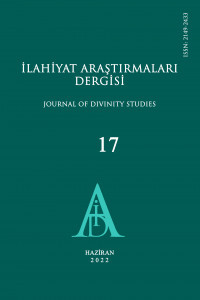The Quran Through The Cognitive Metaphor Theory: How Does God Objectify The Word
In this paper, the Quran, which has been repeatedly read by nearly every society in the world for centuries, and without the influence of cultural indicators such as age, education, gender, race, etc., is analysed in metaphorical sense. This essential text has been interpreted differently by different scholars in different ages. How can the Quran be read and understood by everybody? This is undoubtedly one of the most crucial questions about this holy book. Hence, my aim is to seek an answer to the issue of the Quran and its universality in the context of metaphorical language. For this purpose, I use Lakoff and Johnson’s metaphor theory (known as the cognitive theory of metaphors) to analyse and discuss metaphors in the Quran.
Anahtar Kelimeler:
The Quran, Textual Analysis, Metaphor, Cognitive Theory, Universality
The Quran Through The Cognitive Metaphor Theory: How Does God Objectify The Word
In this paper, the Quran, which has been repeatedly read by nearly every society in the world for centuries, and without the influence of cultural indicators such as age, education, gender, race, etc., is analysed in metaphorical sense. This essential text has been interpreted differently by different scholars in different ages. How can the Quran be read and understood by everybody? This is undoubtedly one of the most crucial questions about this holy book. Hence, my aim is to seek an answer to the issue of the Quran and its universality in the context of metaphorical language. For this purpose, I use Lakoff and Johnson’s metaphor theory (known as the cognitive theory of metaphors) to analyse and discuss metaphors in the Quran.
Keywords:
The Quran, Textual Analysis, Metaphor, Cognitive Theory, Universality,
___
- Allen, J. (2003), “A Question of Language”, In M. Pryke, G. Rose and S. Whatmore (Eds) Using Social Theory: Thinking through Research, London, Thousand Oaks and New Delhi: Sage Publications (in association with Open University).
- Avis, P. (1999), God and the Creative Imagination: Metaphor, Symbol and Myth in Religion and Theology, London and New York: Routledge.
- Barry, P. (2002), Beginning theory: An Introduction to Literary and Cultural Theory, Manchester: Manchester University Press.
- Bazerman, C. and Prior, P. (2004), What Writing Does and How It Does It: An Introduction to Analyzing Texts and Textual Practices, New Jersey: Lawrence Erlbaum Associates.
- Goatly, A. (1997), The Language of Metaphors, London and New York: Routledge.
- Happel S. (2002), Metaphors for God’s Time in Science and Religion, New York: Palgrave Macmillan.
- Hidasi, J. (2008), “Cultural messages of metaphors”. In E. A. Berendt (Ed.) Metaphors for Learning: Cross-cultural Perspectives, Amsterdam and Philadelphia: John Benjamins Publishing Company.
- Huckin, T (2004), “Content Analysis: What Texts Talk About”. In C. Bazerman and P. Prior (Eds.) What Writing Does and How It Does It: An Introduction to Analyzing Texts and Textual Practices, New Jersey: Lawrence Erlbaum Associates.
- Krippendorff, K (2004), Content Analysis: An Introduction to Its Methodology, California: Sage Publications.
- Kövecses, Z. (2002), Metaphor: A Practical Introduction, New York: Oxford University Press
- Lakoff, G. (1986), Women, Fire, and Dangerous Things: What Categories Reveal about the Mind, Chicago and London: The University of Chicago Press.
- Lakoff, G. Johnson, M. (2003), Metaphors We Live By, Chicago: The University of Chicago Press.
- Lakoff, G. Turner, M. (1989), More Than Cool Reason: A Field Guide to Poetic Metaphor, Chicago: The University of Chicago Press.
- MacCormac, E.R. (1990), A Cognitive Theory of Metaphor, London: MIT Press.
- Petrie, H.G and Oshlag, R.S. (1993), “Metaphor and Learning”. In A.Ortony (Ed.) Metaphor and Thought, Cambridge: Cambridge University Press.
- Rose, G. (2003), “Asking questions”. In M. Pryke, G. Rose and S. Whatmore (Eds.) Using Social Theory: Thinking through Research, London, Thousand Oaks and New Delhi: Sage Publications (in association with Open University).
- Scott, J. W. (1988), “Deconstructing Equality-versus-Difference: Or, the Uses of Poststructuralist Theory for Feminism”, Feminist Studies, 14 (1): 32-50.
- Skarmeta, A. (1987), Burning Patience, New York: Pantheon Books.
- Strenski, Ellen (1989), “Disciplines and Communities, Armies and Monasteries and The Teaching of Composition”, Rhetoric Review, 8 (1): 137.
- Yayın Aralığı: Yılda 2 Sayı
- Başlangıç: 2014
- Yayıncı: İslâmî İlimleri Araştırma ve Yayma Vakfı (İSİLAY) İlahiyat Araştırmaları Merkezi (İLAMER)
Sayıdaki Diğer Makaleler
İslâm Siyaset Geleneğinde Muhalefet Üzerine Bazı Mülahazalar –Hulefâ-i Râşidîn Dönemi–
The Quran Through The Cognitive Metaphor Theory: How Does God Objectify The Word
Kırgızistan Kültür, Sanat ve Tarih Gezisi (21-25 Mayıs 2016)
Türk Musikîsî'nin Arap Musikîsî'ne Tesiri
Muhammed el-Mâlikî’nin Sabır Anlayışı
Kırgızistan’da Selefilikle Başedebilmek Açısından Mâturidîliğin Önemi
